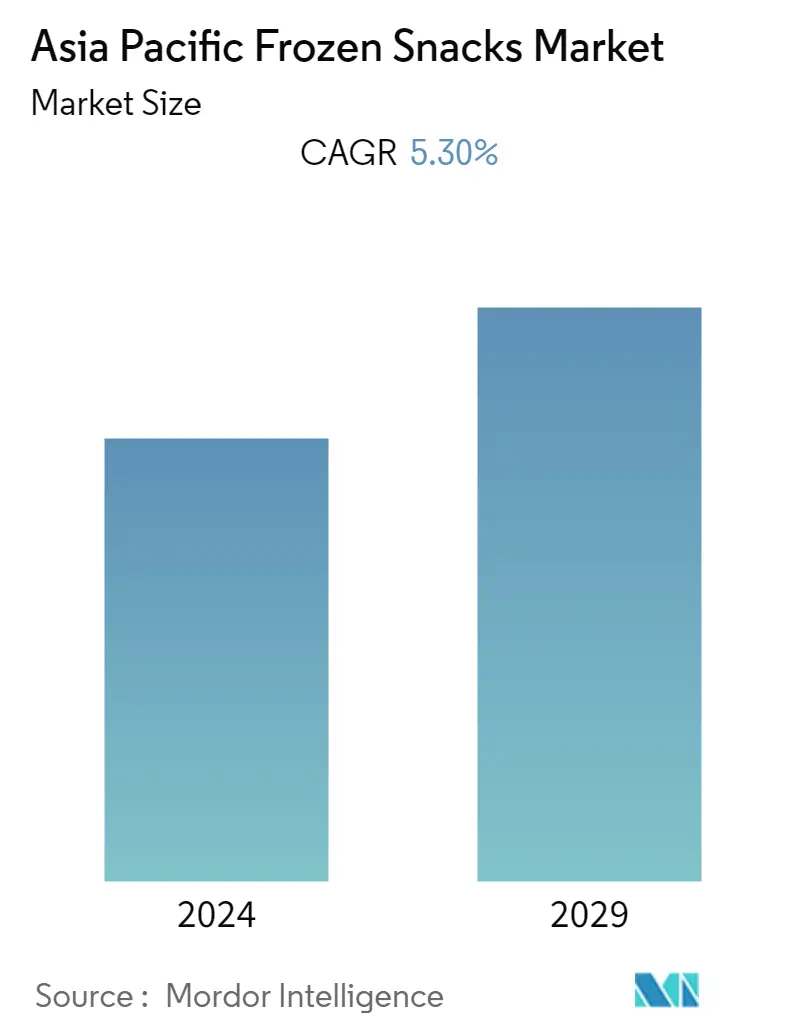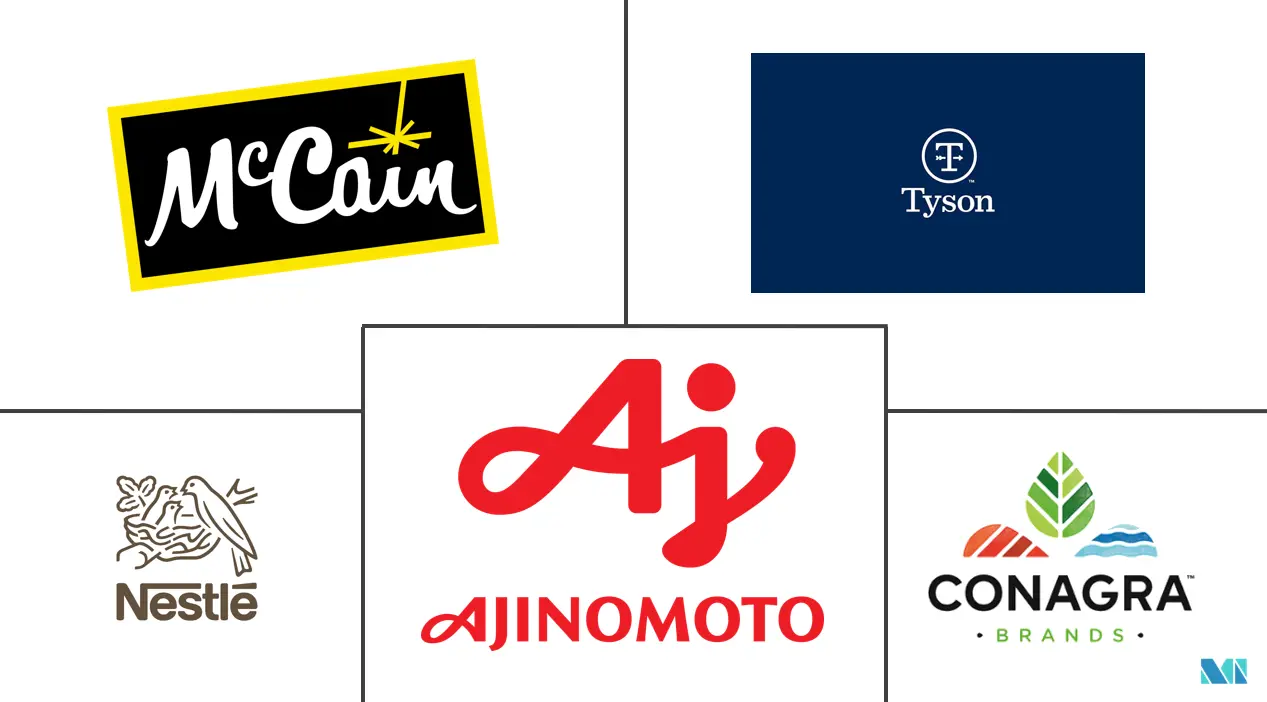Market Size of Asia Pacific Frozen Snacks Industry

| Study Period | 2019 - 2029 |
| Base Year For Estimation | 2023 |
| Forecast Data Period | 2024 - 2029 |
| Historical Data Period | 2019 - 2022 |
| CAGR | 5.30 % |
| Market Concentration | Low |
Major Players
*Disclaimer: Major Players sorted in no particular order |
APAC Frozen Snacks Market Analysis
The Asia Pacific frozen snacks market is projected to register a CAGR of 5.3% during the forecast period (2022-2027)
The market growth in the region is mainly driven by the rising popularity of frozen potato fries, potato wedges, and other potato products among millennial consumers. Further, Asian countries like China and India were among the major producers of potatoes worldwide, in 2020, according to FAO (The U.S. Food and Agriculture Organization). With the availability of a large volume of potatoes in the region and a high consumer affinity for potato-based food are enabling key manufacturers to produce a large assortment of potato-based frozen snacks. Furthermore, the busy lifestyles of the urban population are influencing the adoption of longer shelf life and convenience food options such as frozen snacks.
In the medium term, demand for plant-based snack products is expected to expand exponentially due to the consumer's inclination toward healthy food habits. Plant-based sausages, nuggets, and burger patties are a few of the products preferred by Asian consumers to replace conventional snack food.
Further, the outbreak of COVID-19 encouraged consumers to consume frozen snacks as longer shelf life snacks and ready-to-eat food is registering high demand owing to the work-from-home culture. For instance, ITC India, in its press release disclosed that the company's frozen snacks business has grown three times since the pandemic occurred. Also, the reach of the company's frozen foods extended from 12 towns to 132 towns from May to July 2020.
APAC Frozen Snacks Industry Segmentation
Frozen snacks are a type of snack food that has been subjected to rapid freezing and kept frozen until used. The Asia pacific frozen market is segmented by product type, distribution channel, and geography. By product type, the market is segmented into fruit-based snacks, potato-based snacks, meat, and seafood-based snacks, and others. On the basis of distribution channels, the market is segmented into supermarkets/hypermarkets, convenience stores, online retail channels, and other distribution channels. It provides an analysis of emerging and established economies across the region, comprising China, Japan, India, Australia, and the Rest of Asia Pacific. For each segment, the market sizing and forecasts have been done on the basis of value(in USD million).
| Product Type | |
| Fruit based Snacks | |
| Potato based Snacks | |
| Meat and Seafood based Snacks | |
| Other |
| By distribution channel | |
| Supermarkets/ Hypermarkets | |
| Convenience Stores | |
| Online Retail Stores | |
| Other Distribution Channels |
| By Geography | |
| China | |
| India | |
| Japan | |
| Australia | |
| Rest of Asia Pacific |
Asia Pacific Frozen Snacks Market Size Summary
The Asia Pacific frozen snacks market is experiencing significant growth, driven by the increasing popularity of potato-based products among millennial consumers and the region's substantial potato production. The convenience and longer shelf life of frozen snacks are appealing to the urban population with busy lifestyles. The market is also witnessing a shift towards plant-based snack products, as consumers increasingly prefer healthier food options. The COVID-19 pandemic has further boosted the demand for frozen snacks, as consumers sought longer-lasting and ready-to-eat food solutions. This trend has been supported by improved supply chain infrastructure and logistics, making a variety of frozen snacks more accessible. The adoption of Western-style diets is also contributing to the market's expansion, with frozen U.S. and European snack products gaining popularity.
In India, the frozen snacks market is being propelled by urban consumers familiar with similar products from Quick-Service Restaurants and food stalls. The availability of traditional favorites in frozen formats is attracting a broader consumer base. The rise of online grocery shopping is expected to further drive demand, with private labels offering a range of freeze-dried foods through digital channels. The market is highly fragmented, with numerous regional and international players like McCain Foods, Nestle, and Tyson Foods competing for market share. These companies are expanding their product portfolios and distribution networks to meet consumer demand. Innovations in packaging and freezing technologies are also enhancing product appeal, while the introduction of plant-based frozen products is catering to the growing demand for vegan options.
Asia Pacific Frozen Snacks Market Size - Table of Contents
-
1. MARKET DYNAMICS
-
1.1 Market Drivers
-
1.2 Market Restraints
-
1.3 Porter's Five Force Analysis
-
1.3.1 Threat of New Entrants
-
1.3.2 Bargaining Power of Buyers/Consumers
-
1.3.3 Bargaining Power of Suppliers
-
1.3.4 Threat of Substitute Products
-
1.3.5 Intensity of Competitive Rivalry
-
-
-
2. MARKET SEGMENTATION
-
2.1 Product Type
-
2.1.1 Fruit based Snacks
-
2.1.2 Potato based Snacks
-
2.1.3 Meat and Seafood based Snacks
-
2.1.4 Other
-
-
2.2 By distribution channel
-
2.2.1 Supermarkets/ Hypermarkets
-
2.2.2 Convenience Stores
-
2.2.3 Online Retail Stores
-
2.2.4 Other Distribution Channels
-
-
2.3 By Geography
-
2.3.1 China
-
2.3.2 India
-
2.3.3 Japan
-
2.3.4 Australia
-
2.3.5 Rest of Asia Pacific
-
-
Asia Pacific Frozen Snacks Market Size FAQs
What is the current Asia Pacific Frozen Snacks Market size?
The Asia Pacific Frozen Snacks Market is projected to register a CAGR of 5.30% during the forecast period (2024-2029)
Who are the key players in Asia Pacific Frozen Snacks Market?
McCain Foods Limited, Conagra Brands, Tyson Foods, Nestle SA and Ajinomoto Inc are the major companies operating in the Asia Pacific Frozen Snacks Market.

